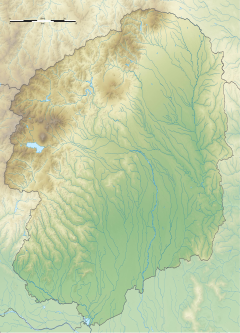Banna-ji
| Banna-ji | |
|---|---|
鑁 a chùa | |
 Banna-ji Hondo (NT) | |
| Religion | |
| Affiliation | Buddhist |
| Deity | Dainichi Nyōrai |
| Rite | Shingon |
| Status | functional |
| Location | |
| Location | 2220 Ietomichō, Ashikaga-shi, Tochigi-ken 326-0803 |
| Country | Japan |
| Geographic coordinates | 36°20′15.1″N139°27′8.1″E/ 36.337528°N 139.452250°E |
| Architecture | |
| Founder | Ashikaga Yoshikane |
| Completed | 1197 |
| Website | |
| Official website | |
Banna-ji(鑁 a chùa)is aBuddhist templeof theShingonsect in the city ofAshikaga,Tochigi Prefecture,in northernKantō regionofJapan.Thehonzonof the temple is a statue ofDainichi Nyōrai,leading to the temple's nickname ofDainichisama,.[1]The temple is built on the ruins of the ancestral fortified residence of theAshikaga clanwho ruled Japan during theMuromachi shogunate,and its grounds are aNational Historic Site[2]

History
[edit]Minamoto no Yoshiyasuwas awarded ashōen(estate) in this area ofShimotsuke Provincein the middle of the 12th century, and constructed a fortified residence. His third son took the name of "Ashikaga" from the place where this estate was located, and becameAshikaga Yoshikane.He served as a vassal ofMinamoto no Yoritomoin theGenpei Warand eventually became Yoritomo's brother-in-law. He was awarded with thegovernorshipof Shimotsuke Province in 1185. Ten years later, in 1195, he retired, becoming a Buddhist monk and taking the name Gishō ( nghĩa xưng ). The following year he installed a statue of Dainichi Nyōrai in his residence, transforming it into a Buddhist temple named Banna-ji. This temple was greatly expanded by his third son,Ashikaga Yoshiuji,in 1234. Yoshiuji is also responsible for building the currentHondōof the temple. The temple was a subsidiary ofTsurugaoka Hachiman-guinKamakurafor the remainder of theKamakura periodandNanboku-cho period.However, by theSengoku period,the power and influence of the Ashikaga clan had waned considerably, and the temple declined into near ruin.
Present situation
[edit]The 40,000 square meter precincts of the temple gained protection as a National Historic Site in March 1922, and the main hall was designated as anImportant Cultural Property of Japanin 1950. The temple still retains many remnants of its origins as a fortifiedsamurairesidence, including moats and earthen ramparts, along with four fortified gates, which date to the 1500s.[3]These features led the temple to be included as one ofJapan's Top 100 Castlesin 2006 by the Japan Castle Foundation.[4]The status of the main hall was raised to that of aNational Treasurein 2013.[5]
Cultural Properties
[edit]Banna-ji Hondō (National Treasure)
[edit]The main hall of Banna-ji was originally constructed in 1234 by Ashikaga Yoshiuji. This structure burned down after being struck by lightning, and was rebuilt in 1299 byAshikaga Sadauji,the father of the famousAshikaga Takauji,founder of the Muromachi shogunate. It is a 5 x 5bayhall with airimoyastyle roof.Although the temple itself is a esoteric Buddhist temple, many of the architectural features of this building are based on the styles ofJapanese Zen.The building was extensively remodeled around 1407 to 1432. It was designated anImportant Cultural Propertyin 1908, and upgraded to aNational Treasurein 2013.[6]
Important Cultural Properties
[edit]Gallery
[edit]-
Large gong at Ashikaga Banna-ji
-
Hondō
-
Shoro containing Bonshō
-
Kyōdō
-
Tahoto Pagoda
See also
[edit]External links
[edit]- Banna-ji website (in Japanese)
- https://web.archive.org/web/20160403214556/http:// jcastle.info/castle/profile/94-Ashikagashi-Yakata
- Ashikaga City - info about Banna-ji Hondō (in Japanese)
- http:// jref /articles/the-100-top-castles-of-japan.267/
References
[edit]- ^"Quốc bảo 鑁 a chùa".ashikaga-bannaji.org.Retrieved2016-08-18.
- ^"Đủ lợi thị trạch tích ( 鑁 a chùa )".Cultural Heritage Online(in Japanese). Agency for Cultural Affairs.Retrieved5 August2020.
- ^Ashikagashi-Yakata J Castlehttp:// jcastle.info/castle/profile/94-Ashikagashi-YakataArchived2016-04-03 at theWayback Machine
- ^"Nhật Bản 100 danh thành | công ích tài đoàn pháp nhân Nhật Bản thành quách hiệp hội".Công ích tài đoàn pháp nhân Nhật Bản thành quách hiệp hội(in Japanese). 2015-12-12.Retrieved2016-08-18.
- ^"Quốc bảo 鑁 a chùa".ashikaga-bannaji.org.Retrieved2016-08-17.
- ^"鑁 a chùa bổn đường".Cultural Heritage Online(in Japanese). Agency for Cultural Affairs.Retrieved5 August2020.
- ^"鑁 a chùa kinh đường".Cultural Heritage Online(in Japanese). Agency for Cultural Affairs.Retrieved5 August2020.
- ^"鑁 a chùa gác chuông".Cultural Heritage Online(in Japanese). Agency for Cultural Affairs.Retrieved5 August2020.








